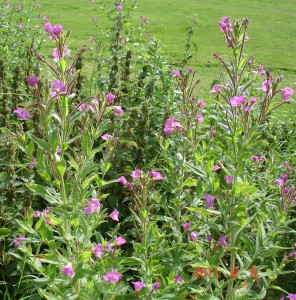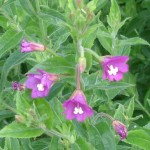Great Willowherb
Latin: Epilobium hirsutum
Latin: Saileachán mór
A native perennial that in broad outline is similar to Epilobium angustifolium except that the whole plant is downy-hairy. It has stout, erect stems growing to a height of 80-150 cm.
It flowers slightly later than Epilobium angustifolium in late June. The flowers are deep purple-pink, about 20mm across, and have 4 notched petals.
It normally occurs in damp wasteland, ditches, river banks and occasionally on drier ground. It is particularly abundant in the eastern half of the country.
The leaves can be used to make a tea – this is often drunk inRussia, where it is called ‘kaporie tea’. However, there has been a report that the plant might be poisonous and another says that it causes epileptic-like convulsions.
Established populations of Great Willowherb exist along the headlands in the practice area and in the Builder’s Paddock. Also frequently found in association with American Willowherb in broadleaf spinneys.

